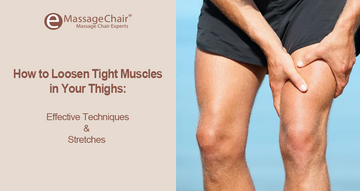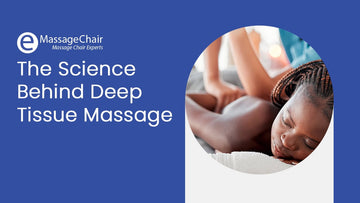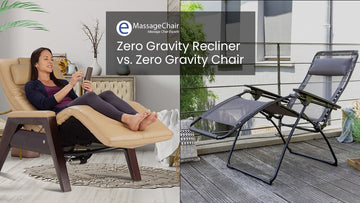Dealing with tight thigh muscles? You're not alone. Whether it's from a sedentary lifestyle, overexertion, or poor posture, tight thigh muscles can hinder your mobility and overall comfort. In this comprehensive guide, we'll explore a range of targeted stretches and muscle relaxation techniques designed to alleviate tension and provide much-needed relief to your thigh muscles. From dynamic stretches to myofascial release, we've got you covered with expert advice.
Understanding Tight Muscles in the Thighs
Before we jump into the techniques, let's explore why those thigh muscles might be feeling tight. Overuse, such as prolonged sitting or repetitive movements, can cause muscles to contract and stay tense. This tension restricts blood flow and limits the muscle's ability to fully relax. Additionally, poor posture can contribute to muscle imbalances and tightness, further exacerbating the issue.
The signs of tight thigh muscles can range from a sensation of stiffness and discomfort to limited movement and even pain. It's essential to pay attention to your body and recognize these signs to address the problem promptly.
Common Causes of Tight Thigh Muscles:
- Overuse or repetitive movements
- Lack of stretching before and after physical activity
- Poor posture
- Sedentary lifestyle
- Injury or muscle strain
Benefits of Loosening Tight Muscles
Why should you bother loosening those tight thigh muscles? The benefits extend beyond just comfort. By effectively addressing muscle tightness, you can experience enhanced flexibility and a broader range of motion. This newfound mobility can lead to improved performance in physical activities and reduce the risk of strains or injuries. Furthermore, loosening tight muscles promotes better blood circulation, which can aid in overall muscle recovery.
Effective Techniques for Loosening Tight Thigh Muscles:
Stretching for Tight Muscles
Dynamic stretching involves controlled movements that take your muscles through their full range of motion. These stretches can effectively warm up your muscles and help alleviate tightness. Here's a dynamic stretch for your thigh muscles:
- Leg Swings: Stand next to a support, like a wall, and gently swing one leg forward and backward. Repeat 10-15 times on each leg.
- Static Stretching: Static stretching is ideal for relaxing muscles and improving flexibility. Hold each stretch for about 20-30 seconds on each side. Here are two static stretches for your thigh muscles:
- Quadriceps Stretch: Standing upright, bend one knee and bring your heel towards your glutes, holding your foot with your hand. Hold the stretch for 20-30 seconds and switch sides.
- Hamstring Stretch: Sit on the floor with one leg extended and the other bent, sole of your foot against your inner thigh. Lean forward from your hips, reaching for your toes. Hold for 20-30 seconds and switch sides.
- Butterfly Stretch:Sit on the floor with the soles of your feet touching each other. Gently press your knees towards the floor. Hold for 30 seconds.
- Pigeon Pose:Start in a push-up position, bring one knee forward, placing it behind your wrist. Extend the other leg straight back. Hold for 30 seconds on each leg.
Techniques for Muscle Relief
Muscle relief techniques provide effective strategies for alleviating tension and discomfort in thigh muscles. These methods promote relaxation, improved blood circulation, and overall muscle well-being. Here are some key techniques:
-
Foam Rolling: Utilizing a foam roller, this technique involves applying pressure to the thigh muscles. By rolling back and forth, specifically targeting tight areas, the process helps to alleviate muscle knots and tension. Extra attention should be given to tense spots for optimal relief.
-
Heat Therapy: Applying a warm towel or heating pad to the thighs for 15-20 minutes can aid in muscle relaxation and enhance blood flow. The heat helps to soothe muscle tightness and promote healing.
-
Massage: Professional massages, massage chairs, or massage tools can be employed to knead and release tension within the thigh muscles. This technique offers a hands-on approach to effectively address muscle discomfort.
-
Active Rest: Engaging in low-impact activities such as swimming or cycling provides the thigh muscles with a respite while maintaining gentle movement. This approach supports muscle recovery and prevents further strain.
Incorporating Exercise and Movement
Low-impact exercises can significantly improve thigh muscle flexibility. Engage in exercises like walking, swimming, or cycling to gently work your muscles without causing strain. Remember to perform a proper warm-up before exercise to prepare your muscles for movement.
Lifestyle Changes to Prevent and Manage Tight Muscles
Beyond targeted stretches and exercises, making simple lifestyle changes can go a long way in preventing and managing muscle tightness:
- Mind Your Posture: Good posture supports muscle health. Maintain an upright posture while sitting and standing to reduce unnecessary strain on your thigh muscles.
- Hydration and Nutrition: Staying hydrated and consuming a balanced diet provide essential nutrients for muscle health and recovery.
- Take Stretch Breaks: If your day involves prolonged sitting, take short breaks to stretch and walk around. This prevents your thigh muscles from becoming too tight.
Seeking Professional Assistance
If you find that your tight thigh muscles persist or worsen, it's advisable to consult a healthcare or fitness professional. They can provide personalized guidance, recommend specific stretches or exercises, and even suggest techniques like massage therapy or physical therapy.
Conclusion
Loosening tight muscles in your thighs isn't just about relieving discomfort – it's a vital step toward enhancing your overall mobility, flexibility, and well-being. By incorporating self-myofascial release, dynamic and static stretches, and making lifestyle adjustments, you can take control of your muscle health and enjoy the benefits of a more agile and resilient body.






